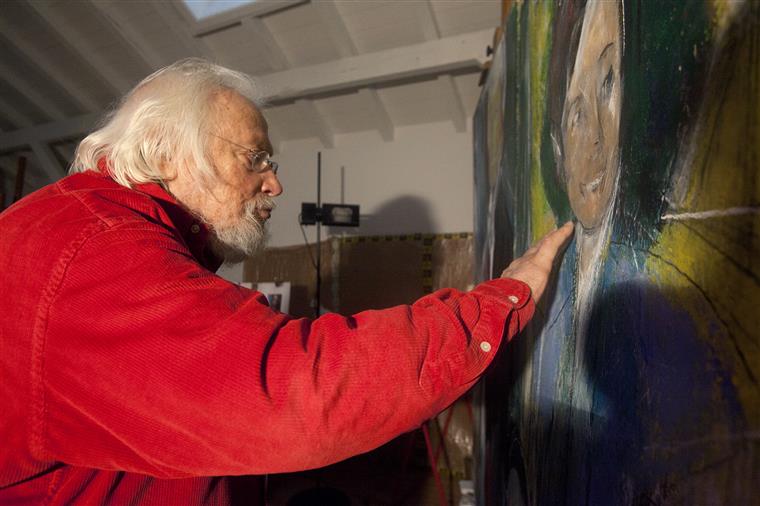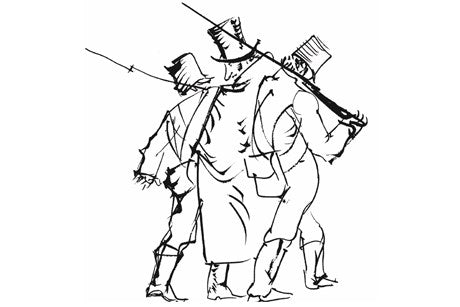
Júlio Pomar (1926-2018), one of the most renowned artists of the Portuguese 20th century, distinguished with numerous awards, with work duly appreciated in countless exhibitions, always had the need to “resort to words” and to be close to them. Not only did he accompany literature with illustrations, he also wrote poetic works and fado lyrics, many of which have already been set to music. Learn more about this fabulous artist.
1.During the school period, he met some of the most important Portuguese artists of the first half of the 20th century.
At the Lisbon art school, which he met Marcelino Vespeira, Mário Cesariny, Fernando de Azevedo, Pedro Oom, José Gomes Pereira and Arthur Cruzeiro Seixas, among others, who were to assert themselves as some of the most important Portuguese artists of the first half of the 20th century. Followed studies for António Arroio, followed, naturally, by the Escola Superior de Belas-Artes in Lisbon, where he entered in 1942. Two years after joining the Fine Arts in Lisbon, he decided to move to Porto, due to the discrimination he former students of António Arroio were targeted. He began attending the School of Fine Arts in Porto, getting to know Fernando Lanhas' group, Júlio Resende It is Amândio Silva, responsible for the so-called “Independent Exhibitions”.

2.The first painting sold was The Mummers to Almada de Negreiros.
The opportunity arose after an exhibition he did with colleagues in the studio they shared on Rua das Flores, right next door. The buyer? José de Almada de Negreiros, who insisted on exhibiting the painting to the public at the VII Modern Art Salon of the National Propaganda Secretariat.

3. Was arrested.
After joining the Communist Youths, still in 1945, and joining the MUD Juvenil the following year, Júlio Pomar he was arrested by the PIDE in 1947. Despite his imprisonment, some of his most emblematic neorealist works, such as Trolha's lunch or Resistance, were even exhibited at the General Exhibition of Visual Arts that year. But the frescoes he painted for Cinema Batalha, in Porto, would not have the same luck: O work, created between 1946 and 1947, were already eliminated after the inauguration by the political police, in 1948. Today, however, “the importance of its neo-realist phase is recognized, in which art takes the form of social protest”.

4. He was a scholarship holder of the Calouste Gulbenkian Foundation, between 1964 and 1966
He settled permanently in the French capital in 1963 and received a scholarship from the Calouste Gulbenkian Foundation between 1964 and 1966. The French capital became his second city: he began to divide his time between Paris and Lisbon, the land where he was born in 1926 and which only returns after the 25th of April. The themes he paints range from the relationship with literature, popular tradition (from seaweed harvesting to bullfighting) and the events of the time, such as May 68, as well as a dialogue with masters of the past (Uccello, Ingres, Courbet, van Eyck, Matisse), crossed with the eroticism that would dominate his work in the 1970s.
5. The First Exhibition Retrospective
The first retrospective of the work of Júlio Pomar was organized in 1978 by the Gulbenkian Foundation and exhibited at its headquarters in Lisbon, at the Soares dos Reis Museum in Porto and, partially, in Brussels. In 1986, a new anthological exhibition was also presented by the Gulbenkian Foundation in museums in São Paulo, Rio de Janeiro and Brasília, and finally at the Modern Art Centre, in Lisbon.

6.Did illustration for several books
Among the numerous works he has illustrated are Tolstoy's “War and Peace” (1956-58); “O Romance de Camilo, by Aquilino Ribeiro (1957); “D. Quixote”, by Cervantes (in 1960 and again in 2005); “The Divine Comedy”, by Dante (1961, drawings reissued in 2006 with new portraits of the author); “Emigrants” and “The Jungle”, by Ferreira de Castro (1966 and 1973); “Pantagruel”, by Rabelais (1967); “Kidama Vivila”, by Gilbert Lely (1977); “Rose et Bleu”, by Jorge Luís Borges (1978); “Message”, by Fernando Pessoa” (1985); “La Chasse au Snark”, by Lewis Carroll (1999).

7. Creation of the Atelier-Museum Júlio Pomar
The year in which Sampaio received the award marked a new phase in the artist's career, with the opening of the Atelier-Museu Júlio Pomar, installed in a building close to his residence in Lisbon. The collection of around 400 works of painting, sculpture, drawing, engraving, serigraphy and decorative arts was deposited in the monographic museum dedicated to his work: the Atelier-Museu Júlio Pomar, founded by the Lisbon City Council and opened to the public in 2013, in a 17th-century building undergoing rehabilitation by the architect Siza Vieira, friend of the painter.

